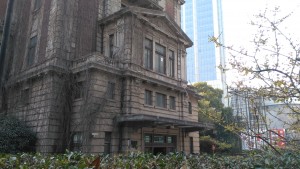Shanghai Street View: Housing History

Shanghai will have yet another major attraction to look forward to in the Year of the Monkey, with word that the museum that tells the story of our city’s history will soon take up a new permanent residence at the former Art Museum on the edge of People’s Square. As a fan of history museums in general, I was quite excited about the development, and have to commend the city on its choice of locations.
More broadly speaking, the new museum will become yet another feather in Shanghai’s cap as it builds up a stable of world-class attractions for both local residents and domestic and international travelers.
One of the biggest coming attractions in that campaign will be our new Disneyland, which will open in June and has just announced ticket prices. Admission will start at 370 yuan ($56), making the park one of the most affordable among the half dozen Disneylands worldwide. But that’s really another story for later this year, and this week the spotlight belongs on our city’s past rather than the future.
Despite my enthusiasm for Shanghai’s brief but very colorful history, even I was unaware the city had a local history museum until just last year. That’s probably because the current museum is really just a temporary residence in the ground floor of the Oriental Pearl Tower in Lujiazui. I personally tend to avoid the tower, mostly because I ended up waiting in 3 separate lines for a combined 2-3 hours to view Shanghai from 3 different levels during my only visit there several years ago.
I never made the pilgrimage to the Shanghai History Museum even after I learned of its existence in the Pearl Tower, mostly because I dreaded the idea of possibly having to wait in some or all of those long lines again just to get inside, and also possibly having to pay the tower’s high entrance fee. It also seemed like housing a museum dedicated to history in that kind of ultra-modern attraction was a bit of a mismatch, especially when there are so many historic buildings that might make better homes.
Against that backdrop, I was quite excited to read this week that the old Art Museum location on Nanjing Road had been selected as the Shanghai History Museum’s new permanent home. The Art Museum was located in the building for years, but moved out more recently to take up its current residence in the former China Pavilion at the World Expo grounds. I’ve been to the Art Museum in its current residence, and think it’s quite well designed and fitting for such a museum that aspires to feature both classical and modern Chinese artists.
Part of Shanghai History

In the meantime, the old Art Museum building on Nanjing Road has mostly housed temporary exhibitions that never seem to be very well attended. That building was only built in 1933, but is very much a part of Shanghai’s boom in the first half of the 20th century when it served as a club for wealthy horse enthusiasts who would come to watch the races on a track that is now the park at People’s Square.
Such a location seems highly appropriate for a museum that has been something of a migrant itself in the 33 years since its establishment in 1983. Since first opening its doors the museum has taken up temporary residence in such places as an agricultural exhibition hall and a building on Hongqiao Road, before finding its latest temporary home in Lujiazui.
The limited size of its homes means that many pieces have never been publicly displayed from its collection of 110,000 objects, most dating from the opening of Shanghai as an international port in 1843 through the establishment of the PRC in 1949. Renovation of the Nanjing Road building will begin this year, and the new museum is expected to open sometime in 2017.
The museum will become the latest among a stable of world-class attractions now opening in the city, including Disneyland, the current Art Museum and the recently built state-of-the-art Shanghai Natural History Museum near Jing’an Temple. I have to commend Shanghai for putting some serious thought into creating this new generation of attractions by finding appropriate locations and styles, and then providing necessary funding to build true world-class attractions.
I always did think the old racing club at People’s Square was a slightly strange choice for the Art Museum in the past, and this new repurposing as the city history museum seems like a much better choice. Perhaps the museum operator may even try to restore some of the building’s old race club elements as part of the renovation, in what would be a fitting and symbolic gesture to telling the story of Shanghai’s rise from a sleepy port town to its current position as China’s commercial and entertainment hub.
